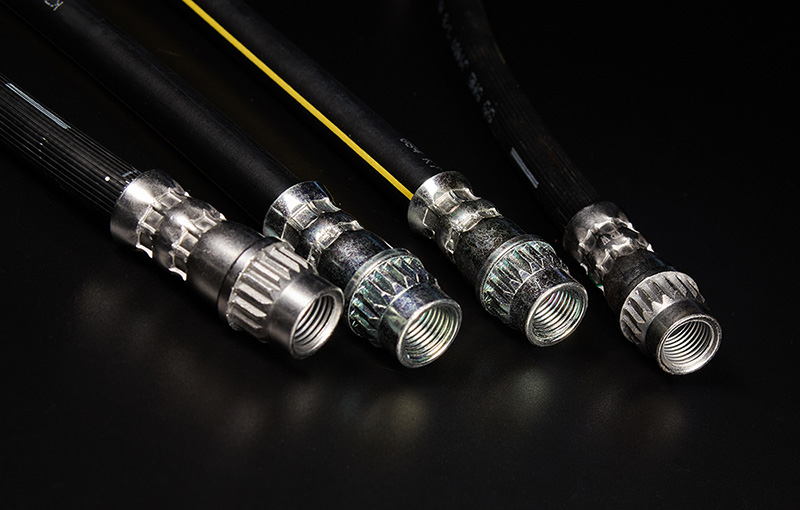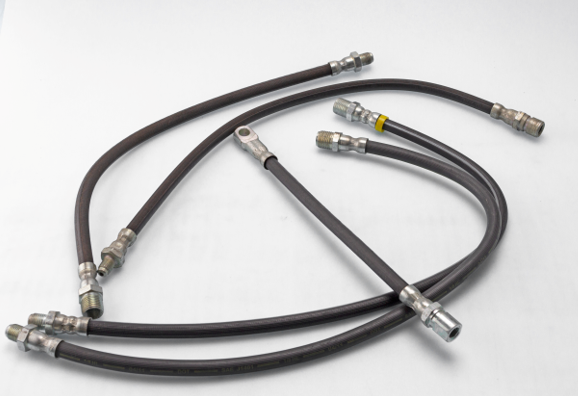
When it comes to brake hoses, choosing between Department of Transportation (DOT) and non-DOT options can make a significant difference in safety, performance, and compliance. Understanding how these two types differ is essential for anyone working in automotive, fleet maintenance, or off-road applications.
What Is a DOT Brake Hose?
A DOT brake hose meets the Department of Transportation (DOT) Federal Motor Vehicle Safety Standards (FMVSS 106). These hoses are required for use on all street-legal vehicles in the U.S.
Key Features of DOT Brake Hoses:
-
Strict manufacturing standards for materials, pressure tolerance, and burst strength
-
Layered construction for abrasion resistance and heat endurance
-
Tested and labeled to ensure traceability and compliance
-
Mandatory in commercial vehicles, trailers, and passenger cars
DOT brake hoses are ideal for OEM replacements, vehicle builds that require certification, and any road-use application where safety and legality are non-negotiable.

What Is a Non-DOT Brake Hose?
Non-DOT brake hoses are not regulated by the Department of Transportation. While they may be built to high standards, they are intended for off-road, racing, agricultural, or custom applications where DOT approval is not required.
Common Uses for Non-DOT Brake Hoses:
-
ATVs, UTVs, and off-highway vehicles
-
Racing applications: Track cars, dragsters, rally vehicles, etc.
-
Farm, construction, and industrial equipment
Why DOT Certification Matters
Using a non-DOT brake hose on a road-legal vehicle can lead to failed inspections, legal liability, or even brake failure. DOT-certified hoses are tested for:
-
Tensile strength
-
Whip resistance
-
Burst pressure
-
Compatibility with brake fluids
-
Performance under heat and pressure
When lives depend on stopping power, compliance isn't optional; it's critical.
How to Identify a DOT-Approved Brake Hose
DOT-approved brake hoses are easy to identify if you know what to look for. The FMVSS 106 standard requires that each hose is permanently labeled with the following:
-
“DOT” marking
-
Manufacturer’s identification code
-
Date code or batch number
-
Hose size or type (optional but common)
These markings are typically printed, etched, or molded directly onto the hose’s outer layer. If a brake hose does not include these labels, it’s not certified for on-road use, even if it appears well-made.
Choosing the Right Brake Hose for Your Application
|
Application Type |
Recommended Hose Type |
| Passenger Cars | DOT |
| Commercial Trucks | DOT |
| Trailers | DOT |
| Off-Road Vehicles | Non-DOT |
| Farm Equipment | Non-DOT |
| ATVs/UTVs | Non-DOT |
| Custom Projects | Depends on street legality |
Brake Hose Material Comparison: DOT vs. Non-DOT
|
Hose Material |
DOT Approved |
Common Applications |
Key Benefits |
Limitations |
|
Rubber Brake Hose |
Yes |
Passenger vehicles, trailers, light-duty trucks |
Flexible, affordable, widely available |
Can degrade over time; less resistant to abrasion |
|
Braided Stainless Steel |
Some (must meet FMVSS 106) |
Performance vehicles, motorcycles, off-road vehicles |
High pressure rating, improved pedal feel, abrasion-resistant |
May be more expensive; not all are DOT compliant |
|
Thermoplastic Brake Hose |
Some types |
Commercial trucks, trailers, agricultural equipment |
Lightweight, corrosion-resistant, customizable assemblies |
Less flexible than rubber in some temps |
|
Custom Non-DOT Hose |
No |
ATVs, UTVs, racing, off-road, farm equipment |
Highly customizable, various fittings & materials |
Not legal for road use; doesn’t meet safety standards |
Need DOT or Non-DOT Brake Hose Assemblies?
At Royal Brass and Hose, we offer a full range of DOT-approved brake hose assemblies as well as custom non-DOT solutions for off-road and specialty equipment. Whether you're replacing a failed line or building something from scratch, we’ve got the inventory and expertise to keep you moving, and stopping, safely. Contact us or visit one of our locations to learn more.
